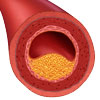Cholesterol boosts the memory of the immune system
The memory of the human immune system is critical for the development of vaccines. Only if the body recognises a pathogen with which it has already come into contact in the case of a second infection, the immune system can combat it more effectively than it did the first time. The Freiburg immunobiologist Prof. Dr. Wolfgang Schamel from the Institute of Biology III of the University of Freiburg and his colleagues have succeeded in demonstrating how the memory of the immune system functions. Their findings have now been published in the journals Immunity and Journal of Biological Chemistry (JBC).
The immune system becomes acquainted with a pathogen during an initial infection and understands that it must be combated. When the T cell receptors of the immune system come across the same pathogen a second time, they are much more sensitive toward them than during the first encounter, and it thus takes less pathogens to activate the immune system. It was previously unclear why the receptors become more sensitive.
In 2011, Schamel’s research group and a team led by Prof. Dr. Balbino Alarcon from the Autonomous University of Madrid, Spain, found the answer to this fundamental question. In a publication in the journal Immunity, they showed that the increased sensitivity is caused by a clustering of the T cell receptors: In a naive cell that has not yet met the pathogen, the receptors are arranged individually on the cell membrane, each fending for itself. A large number of receptors thus needs to be confronted by a large number of pathogens in order for the immune system to react. In a so-called memory cell, which remembers the pathogen, the receptors are arranged in groups on the membrane. When a pathogen binds to a receptor from a cluster, all of the receptors within the cluster are activated at once. This makes the immune system more sensitive.
Now, as reported in the journal JBC, a team of researchers in Freiburg under Schamel and Prof. Dr. Rolf Schubert, professor for pharmaceutical technology and biopharmaceutics at the Institute of Pharmaceutical Sciences of the University of Freiburg, have succeeded in demonstrating how a cell forms these receptor clusters. The critical factors for the success of this endeavour were Schamel’s expertise in biochemical research on T cell receptors and Schubert’s expertise in the production of liposomes. The collaboration between the two teams was made possible by a project funded by BIOSS Centre for Biological Signalling Studies, a Cluster of Excellence at the University of Freiburg.
Dr. Eszter Molnár, a postdoctoral researcher in Schamel’s team, and Dr. Martin Holzer from Schubert’s research group isolated the receptors and reconstructed them in a synthetic membrane. After one and a half years of work, the scientists achieved a breakthrough: They discovered that the composition of the lipids of a membrane is responsible for the clustering of the receptors. The lipid composition of a naive cell differs from that of a memory cell. Cholesterol is the key factor in this process, as it is present in higher concentrations in a memory cell. This higher concentration of cholesterol leads to the aggregation of receptors, because the cholesterol joins them together like glue.
(Source: Uni Freinburg: Journal of Biological Chemistry (JBC): Immunity)
More information
 | For more information on cholesterol, including the health effects of high cholesterol and ways to lower cholesterol levels, as well as some useful tools, see Cholesterol. |
Dates
Tags
Created by:

 Login
Login














